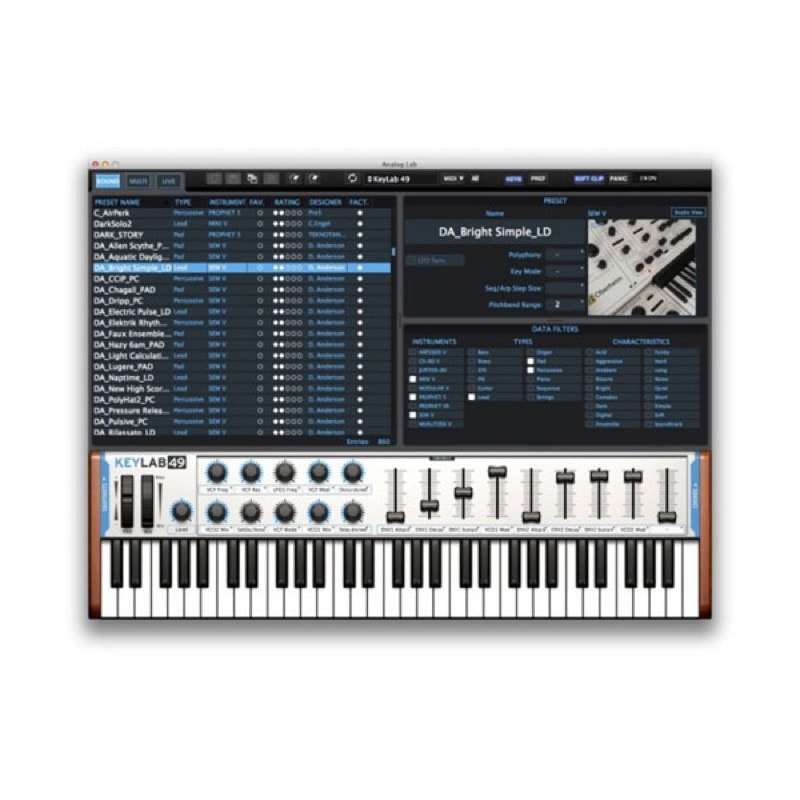

Love it or hate it, the Yamaha DX-7 is just about the most immediately identifiable sound of the 80’s. Sure, it’s a piece of history, but it’s also great for recreating sounds from the early 1980s, no floppy-disk required. One such offering is the CMI V, a reproduction of the Fairlight CMI (Computer Musical Instrument), which was the first commercially available digital sampling system in the world. In addition to ripping sounds, the V Collection 7 also acts as a sort of archival tool, preserving for a new generation the history of its instruments.
REVIEW ARTURIA ANALOG LAB SOFTWARE
If your MIDI controller has pitch bend or modulation wheels, you’ll find that the software responds well and allows for nuanced playing.Įven with just these two units, you could reproduce countless tones found on records from the last 50 years, from ABBA to Zappa and all stops in between. The Mini V3 is actually a collaboration with the iconic Bob Moog, and a faithful adaptation that preserves the spirit of the original. The JUP-8V (pictured above) is a replica of the Roland Jupiter-8, and after dialing it in for just a bit, can absolutely nail the sounds of Michael Jackson’s Thriller.

Each instrument is presented with a photorealistic GUI and all of its original controls intact, so any users fortunate enough to have played the real thing will be familiar with its operation. The V Collection 7’s 24 instruments could be expounded upon ad infinitum, but for the sake of brevity and usefulness we’ll break them down by category: 10 Analog Synths The JUP-8VĪrturia’s analog synthesizer offering includes 10 recreations of popular units spanning decades of production. This can be especially useful for composers who spend most of their time meticulously plotting a beautiful piece and need an elegant solution to hear it played back. In the context of a DAW, each plug-in behaves just like any other virtual instrument: you can play it like a real keyboard using an outboard MIDI controller, or slap it on a MIDI track to apply it’s color and timbre to something you’ve already written.

Once you’ve made the necessary connections to a MIDI controller and a speaker, it’s as simple as double-clicking the application’s shortcut-then you’re ready to perform. By using just one application without the need for a separate host, users can save valuable processing power and cut down on latency (a huge concern in a live environment). The standalone feature is important: it’s what allows the instruments to be used with MIDI controllers for live performance with minimal latency. Piano and electric piano die-hards will find plenty to love too, including some excruciating tone-sculpting options for the acoustic piano samples and a beautiful recreation of two Fender Rhodes models.Įach instrument can be used as a standalone application or in conjunction with a DAW for recording projects. Synth lovers rejoice: not only can you reproduce realistic facsimiles of classic units like the Buchla Music Easel or Roland’s Jupiter 8, you can also use Arturia’s Synthopedia to explore wholly new sounds too. So many instruments on tap makes it an ideal application for virtually any producer or musician in need of a quality set of keys, whether those keys are attached to a digital synthesizer or a grand piano. The V Collection 7 isn’t just one plug-in-it’s 25. Overallīest for: Any project with a focus on keys, including live performances, composition, and recording sessions. We also applied them as plugins using Reaper to see how they might fare for producers who are simply looking for quality sounds to map onto their tracks. To get an idea of how the collection’s instruments might function in a live performance context, we put them through their paces as standalone applications using a MIDI controller keyboard. Try Arturia V Collection 7 How We Reviewed V Collection 7


 0 kommentar(er)
0 kommentar(er)
